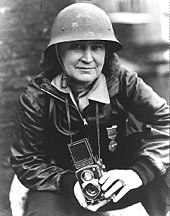Thérèse Bonney
Thérèse Bonney (* 1894 in Syracuse (New York) , † January 15, 1978 in Paris ) was an American photographer and writer who dealt in particular with the victims of World War II .
Life
Thérèse Bonney grew up in New York and California . She studied at the University of California , Harvard and briefly at Columbia University before moving to the Sorbonne . In 1919 she founded an offshoot of the American Red Cross Correspondence Exchange in Paris. In the 1930s she went public, with several exhibitions, among other things, and founded the Bonney Service, a company that supplied images to press products in 33 countries. In 1935 she moved to New York and became director of the Maison Française. This gallery, which was based in the Rockefeller Center , was intended to strengthen cultural ties between the United States and France. In 1938 she published a series of self-made photographs showing life behind the scenes in the Vatican in Life magazine . In the following year she published these pictures in a book.
In 1939 she traveled to Finland to document preparations for the 1940 Olympic Games. Instead, she witnessed and documented the Russian invasion.
After the outbreak of World War II , which she saw as a threat to European civilization, she decided to “try to get the truth and then bring it back and try to make others face it and do something about it”.
In May 1940 she was the only foreign photographer to document the battle between the French and the Germans on the Meuse , and in 1941 she toured Europe and photographed the aftermath of the war.
Her paintings, which often showed children who had lost their homes in the war, became very popular in the United States and elsewhere. She published them in newspapers and magazines; She also published the illustrated books War Comes to the People (1940) and Europe's Children (1943). Another book was published in 1944. In 1948 her film The Search, about children who had become "displaced persons" through the war, came out and won an Academy Award . Bonney has also performed in front of audiences at events at the Library of Congress , the Museum of Modern Art, and numerous other cultural venues. She also became the main character in the comic Photofighter .
Thérèse Bonney stayed in Europe after World War II. Among other things, she had a column in Figaro and translated several French plays so that they could be performed on Broadway.
Anja Tuckermann tells about Mano in her youth book . The boy, who did not know where he was , said Thérèse Bonney accompanied the Sinto boy Mano Höllenreiner from France to Munich after international tracing services found that the family of the boy who was missing after a death march was still alive.
Web links
Individual evidence
- ↑ a b c d Thérèse Bonney on www. britica.com
- ↑ a b c Women Come to the Front on www.loc.gov (with numerous images)
| personal data | |
|---|---|
| SURNAME | Bonney, Thérèse |
| ALTERNATIVE NAMES | Bonney, Mabel Thérèse |
| BRIEF DESCRIPTION | American photo reporter |
| DATE OF BIRTH | 1894 |
| PLACE OF BIRTH | Syracuse (New York) |
| DATE OF DEATH | 15th January 1978 |
| Place of death | Paris |
